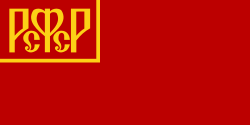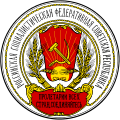"Soviet Russia" redirects here. For the former socialist nation as a whole, see
Soviet Union. For other uses, see
Soviet Russia (disambiguation).
The Russian Soviet Federative Socialist Republic (Russian SFSR or RSFSR; Russian: Российская Советская Федеративная Социалистическая Республика, romanized: Rossiyskaya Sovetskaya Federativnaya Sotsialisticheskaya Respublika, IPA: [rɐˈsʲijskəjə sɐˈvʲetskəjə fʲɪdʲɪrɐˈtʲivnəjə sətsɨəlʲɪˈsʲtʲitɕɪskəjə rʲɪˈspublʲɪkə] ( listen)), also known as the Russian Soviet Republic[9] and the Russian Socialist Federative Soviet Republic,[10] as well as being unofficially referred to as Soviet Russia,[11] the Russian Federation,[12] or simply Russia, was an independent socialist state from 1917 to 1922. Afterwards it was the largest and most populous socialist republics of the Soviet Union (USSR) from 1922 to 1991. When the Soviet Union collapsed, the Russian SFSR became the Russian Federation.[13]
listen)), also known as the Russian Soviet Republic[9] and the Russian Socialist Federative Soviet Republic,[10] as well as being unofficially referred to as Soviet Russia,[11] the Russian Federation,[12] or simply Russia, was an independent socialist state from 1917 to 1922. Afterwards it was the largest and most populous socialist republics of the Soviet Union (USSR) from 1922 to 1991. When the Soviet Union collapsed, the Russian SFSR became the Russian Federation.[13]
Quick Facts Российская Советская Федеративная Социалистическая РеспубликаRossiyskaya Sovetskaya Federativnaya Sotsialisticheskaya Respublika, Status ...
Russian Soviet Federative
Socialist Republic Российская Советская Федеративная Социалистическая Республика
Rossiyskaya Sovetskaya Federativnaya Sotsialisticheskaya Respublika[1] |
|---|
|
Top: Flag
(1918–1925)
Bottom: Flag
(1954–1991)
Top: Emblem
(1918–1920)
Bottom: Emblem
(1978–1991)
|
Motto: Workers of the world, unite!
Пролетарии всех стран, соединяйтесь!
Proletarii vsekh stran, soyedinyaytes'! (tr.) |
| Anthem: |
 The Russian SFSR (red) within the Soviet Union (red and white) between 1956 and 1991 |
| Status | |
|---|
| Capital | |
|---|
| Largest city | Moscow |
|---|
| Official languages | Russianb |
|---|
| Recognised languages | See Languages of Russia |
|---|
| Religion | |
|---|
| Demonym(s) | Russian |
|---|
| Government | |
|---|
| Head of state | |
|---|
|
• 1917 (first) | Lev Kamenevc |
|---|
• 1990–1991 (last) | Boris Yeltsind |
|---|
|
|
| Head of government | |
|---|
|
• 1917–1924 (first) | Vladimir Lenine |
|---|
• 1990–1991 | Ivan Silayevf |
|---|
• 1991 (last) | Boris Yeltsing |
|---|
|
|
| Legislature | |
|---|
| Historical era | |
|---|
|
• October Revolution | 7 November 1917 |
|---|
| 1917–1923 |
|---|
• Soviet republic proclaimed | 25 January 1918 |
|---|
| 30 December 1922 |
|---|
| 19 February 1954 |
|---|
• State sovereignty | 12 June 1990 |
|---|
• Belovezh Accords | 12 December 1991 |
|---|
• Russian SFSR renamed into the Russian Federation | 25 December 1991 |
|---|
| 26 December 1991 |
|---|
• End of the Soviet political system | 25 December 1993 |
|---|
|
|
|
| 1956[source?] | 17,125,200 km2 (6,612,100 sq mi) |
|---|
|
|
| 147,386,000 |
|---|
|
|
| Currency | Soviet ruble (Rbl)h (SUR) |
|---|
| Time zone | (UTC +2 to +12) |
|---|
| Calling code | +7 |
|---|
| ISO 3166 code | RU |
|---|
| Internet TLD | .su |
|---|
|
|
- Remained the national anthem of Russia until 2000.
- Official language in the courts from 1937.[6]
- As Chairman of the VTsIK (All-Russian Central Executive Committee).
- As chairman the Supreme Soviet of the RSFSR from 29 May 1990 to 10 July 1991, then as President.
- As Chairman of the Council of People's Commissars of the Russian SFSR
- As Chairmen of the Council of Ministers – Government of the Russian SFSR
- Served as acting head of government while President of Russia
- Between 1917 and 1919 the Imperial ruble lost all of its value due to overprinting. It would be replaced that same year by the new Soviet ruble.[7]
|
Seven Hero City awards The Russian Democratic Federative Republic existed briefly on 19 January 1918, but actual sovereignty was still in the hands of the Soviets even after the Russian Constituent Assembly opened its first and last session in 1918. [8] |
Close
![]() listen)), also known as the Russian Soviet Republic[9] and the Russian Socialist Federative Soviet Republic,[10] as well as being unofficially referred to as Soviet Russia,[11] the Russian Federation,[12] or simply Russia, was an independent socialist state from 1917 to 1922. Afterwards it was the largest and most populous socialist republics of the Soviet Union (USSR) from 1922 to 1991. When the Soviet Union collapsed, the Russian SFSR became the Russian Federation.[13]
listen)), also known as the Russian Soviet Republic[9] and the Russian Socialist Federative Soviet Republic,[10] as well as being unofficially referred to as Soviet Russia,[11] the Russian Federation,[12] or simply Russia, was an independent socialist state from 1917 to 1922. Afterwards it was the largest and most populous socialist republics of the Soviet Union (USSR) from 1922 to 1991. When the Soviet Union collapsed, the Russian SFSR became the Russian Federation.[13]




